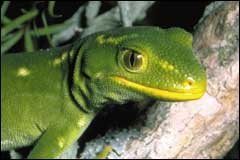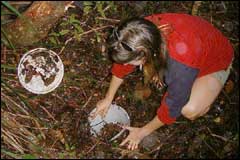Geckos
 The offspring of this green tree gecko may be yellow which makes it difficult to camouflage themselves in their tree habitat |
|
 Helema checks a pitfall trap for geckos on the slopes of Mt Hirakimata |
There are two types of gecko in New Zealand; nocturnal and diurnal. The nocturnal geckos (genus Hoplodactylus) are found in a variety of habitats. The diurnal or daytime geckos (genus Naultinus) are usually found in trees or shrubs especially manuka.
Geckos use scent to detect food such as flowers, nectar and fruit. Insects are the main food in a gecko's diet. Quick to notice movement, geckos stalk their prey, creeping up and snapping them in their jaws. The gecko's small sharp peg-like teeth are used for biting their food before swallowing it.
Geckos make a variety of sounds. Barks and chirps are used to deter predators and to communicate with other geckos. They also have great hearing.
Geckos are loners and many are territorial, defending their patch from other geckos with intimidating tactics such as raising their bodies and opening their brightly coloured mouths.
New Zealand geckos have adapted to the cooler climate. Nocturnal geckos come out in the day to bask in the sun. Females have adapted to the cooler climate in New Zealand by not laying their eggs. The fertilised eggs remain warm inside the pregnant female and hatch internally producing live young.
Hoplodactylus geckos have made adaptations by becoming paler in bright light and lighter as the light diminishes. This may help with their ability to warm themselves (thermoregulation) because darker colours absorb more heat which would allow the gecko to make the best use of the warmth available.
The following table is a summary of information about geckos.
|
Parts of a Gecko |
Features |
Major Functions |
|
Skin
|
Coloured markings Granular scales Loose fitting Sloughing off skin all at once |
Camouflage Receive warmth Processing UV light for bone growth Growth |
|
Eyes |
Quick to spot movement Fixed eyelid |
Ocular lens Locating food Interaction with other geckos |
|
Ears |
Placed behind eyes |
Hearing food |
|
Nose |
Highly developed sense of smell |
Detecting food |
|
Mouth |
Brightly coloured mouth Spoon shaped tongue Sharp peg like teeth
|
Scaring invaders Eating and spreading seeds Licking nectar Licking eyes to clean them Biting and gripping insects Large vocal range |
|
Tail
|
Can drop its tail Assists movement |
Escaping predators Climbing Reproductive organs in males |
|
Legs and Feet
|
Paired limbs Claws on toes Hair-like structures on pads of feet
|
Gripping smooth surfaces Running, climbing, jumping, lunging Stalking prey |
|
Young
|
Eggs hatched inside female Live young 1 or 2 in a litter |
Reproduction Warmth for incubation |